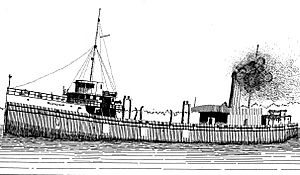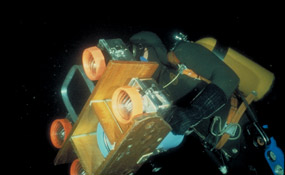SS Glenlyon facts for kids
 |
|
Quick facts for kids History |
|
|---|---|
| Name | Glenlyon |
| Operator | Midland Shipbuilding Company |
| Builder | F. W. Wheeler |
| Launched | February 4, 1893 |
| Acquired | 1914 |
| Out of service | November 1, 1924 |
| Fate | Sunk off the shore of Isle Royale in Lake Superior |
| General characteristics | |
| Type | Freighter |
| Length | 328 ft (100 m) |
| Beam | 42.5 ft (13.0 m) |
| Depth | 20.5 ft (6.2 m) |
| Installed power | 1,200 hp (890 kW) |
| Propulsion | Triple expansion steam engine |
| Capacity | 3,800 tons |
| Notes | Canadian Official # 126660; American #81427 |
|
GLENLYON
|
|
| Location | Glenlyon Shoals off Menagerie Island in Siskiwit Bay, Isle Royale National Park, Michigan |
| Area | 91.8 acres (37.2 ha) |
| Built | 1893 |
| Architect | F. W. Wheeler |
| Architectural style | Freighter |
| MPS | Shipwrecks of Isle Royale National Park TR |
| NRHP reference No. | 84001750 |
| Added to NRHP | June 14, 1984 |
The Glenlyon was a large cargo ship, called a freighter, built way back in 1893. It sailed on the Great Lakes, carrying goods like wheat. Sadly, in 1924, it sank in a big storm near Isle Royale National Park in Lake Superior. Today, its remains are still resting on the lake bottom. The wreck was added to the National Register of Historic Places in 1984 because of its historical importance.
The Story of the Glenlyon
The ship we know as the Glenlyon was first built in 1893. It was made by a company called F. W. Wheeler & Company. Its first name was the William H. Gratwick. The ship was built for John Mitchell & Company, located in Cleveland, Ohio.
The William H. Gratwick was a modern ship for its time. It had a strong steel body and was powered by steam. It was 328 feet (100 m) long and 42.5 feet (13.0 m) wide. The ship could carry a huge amount of cargo, about 3,800 tons. It had two decks and three tall masts.
The ship was launched into the water on February 4, 1893. It was special because it used one of Wheeler's new engines. This engine was a powerful 1,200-horsepower (890 kW) triple expansion steam engine.
Over the years, the William H. Gratwick was sold many times. It changed owners in 1899, 1902, 1907, and 1910. In 1910, it was bought by the Chicago & Duluth Transportation Company. This ship was quite unique for the Great Lakes. It carried both packaged goods and bulk cargo. For a short time, it even carried passengers for both the U.S. and Canada.
In 1912, the Chicago & Duluth company changed the ship's name to the Minnekahta. It was sold again in 1913. Finally, in 1914, the Great Lakes Transportation Company Ltd. bought the ship. This company was from Midland, Ontario, Canada. They fixed up the ship and changed its name one last time to the Glenlyon. At this point, it also became a Canadian-registered ship.
The Final Voyage and Sinking
On October 30, 1924, the Glenlyon left Thunder Bay, Ontario. It was carrying a massive load of wheat, about 143,000 bushels. But the weather quickly turned very bad. The ship had to anchor for safety near the Welcome Islands.
On October 31, the captain decided to continue the journey. However, the winds grew stronger again. The Glenlyon headed for shelter in Siskiwit Bay, which is part of Isle Royale. In the early morning of November 1, 1924, disaster struck. The ship hit a hidden reef near Menagerie Island. This reef is now named after the ship.
The ship sent out a distress call for help. The captain turned off the pumps to try and keep the ship stable on the reef. Other ships from the Great Lakes Transportation fleet rushed to the scene. The Coast Guard also arrived quickly. Most of the crew members were rescued by late morning.
However, two crew members had gone overboard in a lifeboat. No one knew why they left the ship. A search began for them. Luckily, they were found safe early the next morning. They had made it ashore in Siskiwit Bay.
After the sinking, people tried to save the cargo. They managed to recover about 75,000 bushels of wheat over a few weeks. But the ship's condition got worse and worse. Eventually, they had to stop trying to save anything else. The Glenlyon soon broke in half. By April of the next year, the entire ship was completely underwater.
Exploring the Wreck Today
The Glenlyon wreck lies in the cold waters of Lake Superior. This cold water has helped preserve the ship's structure. The wreck is found in water that is 15 to 60 feet (4.6 to 18.3 m) deep.
Today, the wreck of the Glenlyon is open for people to explore. Divers can visit it, though it's not as commonly visited as some other wrecks. In 2009, it was visited fewer than 20 times. This was out of over 1,000 dives made to wrecks in the Isle Royale National Park.
The wreckage of the ship is spread out on the lake floor. The front part of the ship, called the bow, is on one side of the reef. The back part, called the stern, is on the other side. Even though it's scattered, many pieces are easy to recognize. They are often found close to where they were on the original ship. Almost the entire ship is still there.
Some big parts of the ship are still in one piece. This includes the bow section. You can also see the engine room, with its drive shaft, propeller, engine, and boilers. The ship's cabin is also still easy to spot.
The Glenlyon is very important to study. It shows a special time in ship design. Back then, freighters were quickly getting longer. Ships like the SS Lakeland were 300 feet (91 m) long in 1886. But by 1895, they were reaching 400 feet (120 m). The Glenlyon is a great example of a ship from this "transition" period. It's the only known ship of its type and size that can be studied today.
Experts have surveyed the Glenlyon wreck many times. These surveys have created maps of the wreckage. They also show how parts of the wreck move around the lake floor. This movement happens because of currents and ice.




